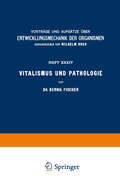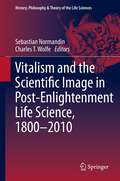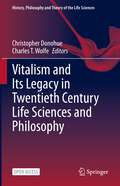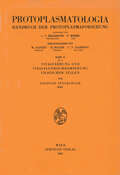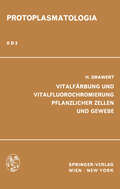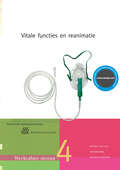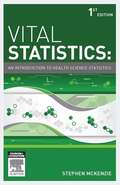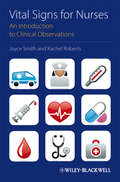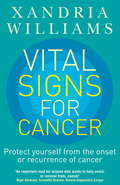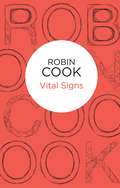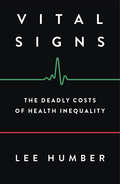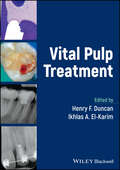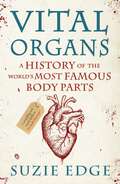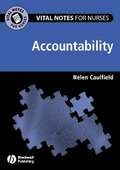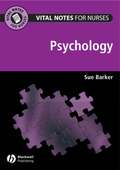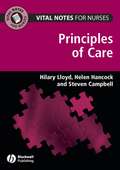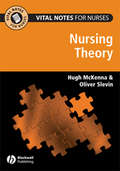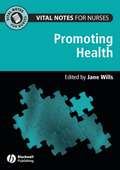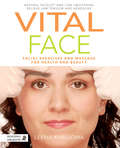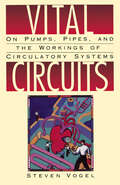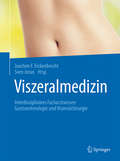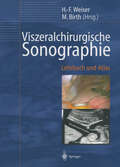- Table View
- List View
Vitalismus und Pathologie (Vorträge und Aufsätze über Entwicklungsmechanik der Organismen #34)
by Bernh. FischerDieser Buchtitel ist Teil des Digitalisierungsprojekts Springer Book Archives mit Publikationen, die seit den Anfängen des Verlags von 1842 erschienen sind. Der Verlag stellt mit diesem Archiv Quellen für die historische wie auch die disziplingeschichtliche Forschung zur Verfügung, die jeweils im historischen Kontext betrachtet werden müssen. Dieser Titel erschien in der Zeit vor 1945 und wird daher in seiner zeittypischen politisch-ideologischen Ausrichtung vom Verlag nicht beworben.
Vitalism and the Scientific Image in Post-Enlightenment Life Science, 1800-2010 (History, Philosophy and Theory of the Life Sciences)
by Sebastian Normandin and Charles T. WolfeVitalism is understood as impacting the history of the life sciences, medicine and philosophy, representing an epistemological challenge to the dominance of mechanism over the last 200 years, and partly revived with organicism in early theoretical biology. The contributions in this volume portray the history of vitalism from the end of the Enlightenment to the modern day, suggesting some reassessment of what it means both historically and conceptually. As such it includes a wide range of material, employing both historical and philosophical methodologies, and it is divided fairly evenly between 19th and 20th century historical treatments and more contemporary analysis. This volume presents a significant contribution to the current literature in the history and philosophy of science and the history of medicine.
Vitalism and Its Legacy in Twentieth Century Life Sciences and Philosophy (History, Philosophy and Theory of the Life Sciences #29)
by Charles T. Wolfe Christopher DonohueThis Open Access book combines philosophical and historical analysis of various forms of alternatives to mechanism and mechanistic explanation, focusing on the 19th century to the present. It addresses vitalism, organicism and responses to materialism and its relevance to current biological science. In doing so, it promotes dialogue and discussion about the historical and philosophical importance of vitalism and other non-mechanistic conceptions of life. It points towards the integration of genomic science into the broader history of biology. It details a broad engagement with a variety of nineteenth, twentieth and twenty-first century vitalisms and conceptions of life. In addition, it discusses important threads in the history of concepts in the United States and Europe, including charting new reception histories in eastern and south-eastern Europe. While vitalism, organicism and similar epistemologies are often the concern of specialists in the history and philosophy of biology and of historians of ideas, the range of the contributions as well as the geographical and temporal scope of the volume allows for it to appeal to the historian of science and the historian of biology generally.
Vitalfärbung und Vitalfluorochromierung Tierischer Zellen (Protoplasmatologia Cell Biology Monographs #2 / D / 1)
by Leopold StockingerVitalfärbung und Vitalfluorochromierung Pflanzlicher Zellen und Gewebe (Protoplasmatologia Cell Biology Monographs #2 / D / 3)
by H. DrawertVitale functies en reanimatie: Werkcahier Kwalificatieniveau 4 (Skillslab-serie)
by Transferpunt VaardigheidsOnderwijsDit cahier gaat over het handelen als verpleegkundige in situaties waarin de zorgvrager geconfronteerd wordt met een levensbedreiging, doordat een of meerdere vitale lichaamsfuncties (bewustzijn, circulatie en ademhaling) verstoord of uitgevallen zijn. Vaardigheden in inhoudelijke analyses: het observeren van het bewustzijneerste hulp bij (dreigend) flauwvallenhet observeren van de circulatie en het verlenen van eerste hulpeerste hulp bij ernstig uitwendig bloedverlieshet observeren van de respiratie en het verlenen van eerste hulpeerste hulp bij hyperventilatietoedienen van zuurstof met behulp van een O2–cilinderreanimeren volwassenereanimeren kindzorg voor een vrije luchtweg bij een bewusteloze cliënt en het opheffen van een luchtwegobstructiehet uitzuigen van de luchtwegen (maakt onderdeel uit van het observeren van de respiratie en het verlenen van eerste hulp)Dit cahier is aangepast aan de nieuwste reanimatierichtlijnen. Daarnaast is een nieuwe analyse opgenomen met als onderwerp basale reanimatie bij volwassenen, waarbij de AED (Automatische Externe Defibrillator) gebruikt wordt. Verder is de cd–rom aangepast aan de nieuwe richtlijnen.
Vital statistics - E-Book: An introduction to health science statistics
by Stephen McKenzieVital Statistics: an introduction to health science statistics e-book is a new Australian publication. This textbook draws on real world, health-related and local examples, with a broad appeal to the Health Sciences student. It demonstrates how an understanding of statistics is useful in the real world, as well as in statistics exams. Vital Statistics: an introduction to health science statistics e-book is a relatively easy-to-read book that will painlessly introduce or re-introduce you to the statistical basics before guiding you through more demanding statistical challenges. Written in recognition of Health Sciences courses which require knowledge of statistical literacy, this book guides the reader to an understanding of why, as well as how and when to use statistics. It explores: How data relates to information, and how information relates to knowledgeHow to use statistics to distinguish information from disinformationThe importance of probability, in statistics and in life That inferential statistics allow us to infer from samples to populations, and how useful such inferences can beHow to appropriately apply and interpret statistical measures of difference and associationHow qualitative and quantitative methods differ, and when it’s appropriate to use eachThe special statistical needs of the health sciences, and some especially health science relevant statisticsThe vital importance of computers in the statistical analysis of data, and gives an overview of the most commonly used analyses Real-life local examples of health statistics are presented, e.g. A study conducted at the Department of Obstetrics and Gynecology, University of Utah School of Medicine, explored whether there might be a systematic bias affecting the results of genetic specimen tests, which could affect their generalizability. Reader-friendly writing style t-tests/ ANOVA family of inferential statistics all use variants of the same basic formula Learning Objectives at the start of each chapter and Quick Reference Summaries at the end of each chapter provide the reader with a scope of the content within each chapter.
Vital Signs for Nurses: An Introduction to Clinical Observations
by Joyce Smith Rachel RobertsAccurate clinical observations are the key to good patient care and fundamental to nursing practice. Vital Signs for Nurses will support anyone in care delivery to enhance their skills, reflect upon their own practice and assist in their continuing professional development. This practical introductory text explores how to make assessments of heart rate, blood pressure, temperature, pain and nutrition. It also looks at issues of infection control, record-keeping and legal and ethical considerations. With case studies and examples throughout, this text will be invaluable to all healthcare assistants, student nurses, Trainee Assistant Practitioners and students on foundation degrees.
Vital Signs for Nurses: An Introduction to Clinical Observations
by Joyce Smith Rachel RobertsAccurate clinical observations are the key to good patient care and fundamental to nursing practice. Vital Signs for Nurses will support anyone in care delivery to enhance their skills, reflect upon their own practice and assist in their continuing professional development. This practical introductory text explores how to make assessments of heart rate, blood pressure, temperature, pain and nutrition. It also looks at issues of infection control, record-keeping and legal and ethical considerations. With case studies and examples throughout, this text will be invaluable to all healthcare assistants, student nurses, Trainee Assistant Practitioners and students on foundation degrees.
Vital Signs For Cancer: How to prevent, reverse and monitor the cancer process
by Xandria WilliamsIn VITAL SIGNS, Xandria Williams explains why current medical treatments for cancer are having so little effect. She draws on her research findings, scientific background and work as a nutritionist and naturopath specialising in cancer to help you to understand the cancer process and give expert advice on how you can detect and reverse the cancer process long before a tumour appears. She gives accessible and practical advice on how to avoid cancer and monitor good health, what to do if you are afraid you may have cancer or be at risk of developing cancer, and complementary and alternative (CAM) approaches to follow if you currently have cancer or have just been diagnosed. These can be used safely alongside medical treatment. She also advises on how you can remain cancer free if you are in remission and want to avoid a recurrence.
Vital Signs (A\medical Thriller Ser.)
by Robin CookWhere life begins, terror lurks... Only Robin Cook, acknowledged master of the techno-medical thriller, could have written this supremely chilling novel about the passion to create life—and the power to destroy it. Millions of readers met crusading epidemiologist Marissa Blumenthal in the pages of the bestselling Outbreak. Now Robin Cook brings back his feisty heroine in a gripping new tale, Vital Signs—a roller-coaster ride into the unexpected and the utterly unconscionable. In the eyes of her envious peers, Marissa has it all: a superb professional reputation, a flourishing pediatrics practice, even a fairy-tale marriage with the man of her dreams—Robert Buchanan, an entrepreneur involved in health-care administration and research. But there is one thing Marissa does not have: the child she desperately desires. And when tests confirm that her sealed fallopian tubes have rendered her infertile, her perfect world begins to crumble. Obsessed with becoming pregnant, Marissa barely even notices the disastrous effect her idée fixe is having on her marriage and career. When a little medical sleuthing points to suspicious origins of her infertility, Marissa boldly challenges the law. Along with Wendy, a new friend with a similar infertility problem, she breaks into a fertility clinic, travels to Australia, a center of in-vitro fertilization, then on to Hong Kong. The two women's exploration of the brave new world of reproductive technologies takes a shocking turn when Wendy is violently killed—and Marissa's own life is mysteriously threatened. But personal danger does not deter her, and she allows herself to be drawn into the dark vortex of the baby-making business, where a woman's dearest dream turns slowly, agonizingly to dread... Timely, top-notch suspense that will grip the reader from the very first page, Vital Signs proves once again the unique and compelling genius of Robin Cook.
Vital Signs: The Deadly Costs of Health Inequality
by Lee HumberNature is no longer the leading cause of death; society is. This makes health care one of the most important political issues today. This book looks at the reasons behind the declining condition of our bodies, as governments across the world choose to neglect the health of the majority of their citizens.Using hard data taken from service users, Lee Humber constructs a sharp analysis that gets to the heart of inequality in health care today, showing that 'wealthy means healthy'. Life expectancy for many in the UK and US is worse than it was 100 years ago, and more and more communities across the world can expect shorter and less healthy lives than their parents.Humber also suggests radical strategies for tackling this degenerative situation, providing a compelling vision for how we can shape our health and that of future generations.
Vital Signs: The Deadly Costs of Health Inequality
by Lee HumberNature is no longer the leading cause of death; society is. This makes health care one of the most important political issues today. This book looks at the reasons behind the declining condition of our bodies, as governments across the world choose to neglect the health of the majority of their citizens.Using hard data taken from service users, Lee Humber constructs a sharp analysis that gets to the heart of inequality in health care today, showing that 'wealthy means healthy'. Life expectancy for many in the UK and US is worse than it was 100 years ago, and more and more communities across the world can expect shorter and less healthy lives than their parents.Humber also suggests radical strategies for tackling this degenerative situation, providing a compelling vision for how we can shape our health and that of future generations.
Vital Pulp Treatment
by Henry F. Duncan Ikhlas A. El-KarimVital Pulp Treatment A comprehensive reference work covering all aspects of vital pulp treatments in clinical practice Vital Pulp Treatment offers a comprehensive overview of existing and developing vital pulp therapies, the science that underpins them as well as their clinical applications. Preserving dental pulp tissue is critical to oral health and vital pulp treatments are designed to maintain, repair, and regenerate this tissue. With a focus on clinical practice, this book begins with the diagnosis and causes of pulpitis before elaborating on the application of vital pulp treatment after trauma, caries, or dental procedures. Later chapters cover a variety of extent treatment modalities including caries removal, pulpotomy, direct or indirect pulp capping and regenerative endodontic therapies. Vital Pulp Treatment readers will also find: Clinical photographs to support and highlight key parts of the text Detailed discussion of topics including pulp diagnostics, deep caries, and pulp exposure management, as well as controversial and clinically relevant discussions Dedicated treatment of each therapeutic modality with a summary of the state of the art in each caseOutcome measures and follow-up guidelines Rooted in evidence-based dentistry and robust scientific research, Vital Pulp Treatment is ideal for dentists, endodontists, restorative dentists, and dental students looking for information on this critical component of modern minimally-invasive dentistry.
Vital Pulp Treatment
by Henry F. Duncan Ikhlas A. El-KarimVital Pulp Treatment A comprehensive reference work covering all aspects of vital pulp treatments in clinical practice Vital Pulp Treatment offers a comprehensive overview of existing and developing vital pulp therapies, the science that underpins them as well as their clinical applications. Preserving dental pulp tissue is critical to oral health and vital pulp treatments are designed to maintain, repair, and regenerate this tissue. With a focus on clinical practice, this book begins with the diagnosis and causes of pulpitis before elaborating on the application of vital pulp treatment after trauma, caries, or dental procedures. Later chapters cover a variety of extent treatment modalities including caries removal, pulpotomy, direct or indirect pulp capping and regenerative endodontic therapies. Vital Pulp Treatment readers will also find: Clinical photographs to support and highlight key parts of the text Detailed discussion of topics including pulp diagnostics, deep caries, and pulp exposure management, as well as controversial and clinically relevant discussions Dedicated treatment of each therapeutic modality with a summary of the state of the art in each caseOutcome measures and follow-up guidelines Rooted in evidence-based dentistry and robust scientific research, Vital Pulp Treatment is ideal for dentists, endodontists, restorative dentists, and dental students looking for information on this critical component of modern minimally-invasive dentistry.
Vital Organs
by Suzie EdgeThe remarkable stories of the world's most famous body parts.Louis XIV's rear end inspired the British National Anthem. Queen Victoria's armpit led to the development of antiseptics.Robert Jenkin's ear started a war.All too often, historical figures feel distant and abstract; more myth and legend than real flesh and blood. These stories of bodies and its parts remind us that history's most-loved, and most-hated, were real breathing creatures who inhabited organs and limbs just like us - until they're cut off that is.Medical historian Dr Suzie Edge investigates over 40 cases of how we've used, abused, dug up, displayed, experimented on, and worshipped body parts, including why Percy Shelley's heart refused to burn; how Yao Niang's toes started a 1000 year long ritual; why a giant's bones are making us rethink medical ethics; and the strange case of Hitler's right testicle.
Vital Notes for Nurses: Accountability (Vital Notes for Nurses #12)
by Helen CaulfieldVital Notes on Accountability is a concise, accessible guide which provides students and newly qualified staff with an understanding of key issues in professional practice. Nurses are accountable for their own practice and require a thorough understanding of their core responsibilities which underpin everyday practice in the health service today. This introductory text in the ‘Vital Notes for Nurses’ series sets out a framework for accountability which consists of four ‘pillars’ - legal, ethical, employment and professional accountability - against which clinical issues can be considered. * Presents legal, ethical, employment and professional issues in an accessible way * Explores accountability, professional regulation, sources of funding and treatment in the health service * Examines complaints, human rights, negligence, consent, and confidentiality * Explores further applications in accountability * Each chapter includes learning objectives, scenarios and case studies
Vital Notes for Nurses: Psychology (Vital Notes for Nurses #13)
by Sue BarkerVital Notes for Nurses: Psychology provides a concise, accessible introduction to key psychological theories and outlines their relevance to nursing practice. Divided into seven chapters, the first offers a preliminary insight into the different perspectives in psychology: Biological, Psychodynamic, Behavioural, Cognitive and Humanistic. These perspectives go on to underpin the topics in all the other chapters. Vital Notes for Nurses: Psychology explores developmental theories, attachment theories, and relationship theories. It discusses issues relevant to nursing practice such as motivation, change, stereotypes, relationships and motivation and looks at issues of suffering, including stress and pain. Illustrated with examples from all branches of nursing practice, this text clearly illustrates the relevance of psychology to nurses. Relates psychological themes specifically to nursing practice Written in a clear, accessible style which assumes no prior knowledge Useful to all nursing students on the common foundation programme as well as newly qualified nurses. Each chapter includes features such as activities, case studies and learning objectives
Vital Notes for Nurses: Principles of Care (Vital Notes for Nurses #15)
by Hilary Lloyd Helen Hancock Steven CampbellVital Notes for Nurses: Principles of Care is an essential guide for nursing students and newly qualified nurses. It provides a concise introduction to the essential principles of nursing care. It encourages nurses to examine the principles and evidence underlying nursing practice and equips them with a thorough understanding of the complexities of patient care in different environments of care. Principles of Care explores concepts of health and illness, conceptual frameworks for practice, principles of health care delivery, and professional standards. Key themes include assessment and planning, implementation and evaluation, patient education and health promotion, decision making and risk management, benchmarking, clinical effectiveness and practice development. * Examines assessment, planning and evaluation of care * Covers risk management and prioritisation of care * Addresses the use of NICE guidance and National service frameworks * Explores clinical effectiveness, practice development and quality assurance * Includes learning objectives, scenarios and case studies
Vital Notes for Nurses: Nursing Models, Theories and Practice (Vital Notes for Nurses #11)
by Hugh McKenna Oliver SlevinVital Notes for Nurses: Nursing Models, Theories and Practice provides a concise, accessible introduction to the development, application and evaluation of nursing theories and clearly outlines their relevance to everyday nursing practice. It encourages the reader to view theories from a broader conceptual base, enabling them to be more objective when it comes to clinical practice. Suitable for nursing students and newly qualified nurses, the authors explore the relationship between nursing theories and practice, specifically analysing their origins, development, selection and use. It discusses how nursing theories evolve, how they relate to nursing roles, how to select a nursing theory relevant to your practice, and how to evaluate theories critically. Key Features: • Clearly examines the relationship between nursing theory, clinical practice and nursing roles • Written in a clear, accessible style which assumes no prior knowledge • Useful to all nursing students on the common foundation programme as well as newly qualified nurses. • Each chapter includes features such as activities, case studies and learning objectives • In the Vital Notes for Nurses series
Vital Notes for Nurses: Promoting Health (Vital Notes for Nurses #16)
by Jane WillsVital Notes for Nurses: Promoting Health is a concise, accessible introduction to health promotion and public health for pre-registration nursing students and newly qualified nurses. Promoting the health and well-being of patients is a vital part of the nursing role. This introductory text in the Vital Notes for Nurses series explores issues such as public health priorities, health inequalities, health promotion settings, and the role of the nurse in health promotion roles. Written in a clear, accessible style which assumes no prior knowledge Each chapter includes learning objectives, case studies, scenarios, activities and learning outcomes Includes specific application to nursing practice in every chapter Identifies strategies for promoting health with individuals and communities and for protecting the health of the general population
Vital Face: Facial Exercises and Massage for Health and Beauty (PDF)
by Leena KiviluomaThis is a unique, revolutionary and totally natural self-care programme developed to treat muscle based health problems and reduce the signs of ageing. The fully-illustrated handbook guides you through stretching and massage techniques to relax the facial, neck and shoulder muscles, with particular emphasis on the jaw, where tension is often held. The exercises address health issues such as teeth clenching and grinding, pain in the face, jaw, head or neck, and can even improve the effects of Bell's Palsy. They also achieve positive cosmetic results such as reduced facial lines and healthy glowing skin. The strengthening exercises will help to lift the facial features and prevent facial sagging. The impact of each exercise is clearly explained so you can concentrate on techniques to target your individual situation, needs and goals. This supportive guide will help anyone who wants to improve the wellbeing and appearance of the face and neck, and will also be of particular interest to those working in the fields of health and beauty.
Vital Circuits: On Pumps, Pipes, and the Workings of Circulatory Systems
by Steven VogelMost of us think about our circulatory system only when something goes wrong, but the amazing story of how it goes right--"magnificently right," as author Steven Vogel puts it--is equally worthy of our attention. It is physically remarkable, bringing food to (and removing waste from) a hundred trillion cells, coursing through 60,000 miles of arteries and veins (equivalent to over twice around the earth at the equator). And it is also intriguing. For instance, blood leaving the heart flows rapidly through the arteries, then slows down dramatically in the capillaries (to a speed of one mile every fifty days), but in the veins, on its way back to the heart, it speed up again. How? In Vital Circuits, Steven Vogel answers hundreds of such questions, in a fascinating, often witty, and highly original guide to the heart, vessels and blood. Vogel takes us through the realm of biology and into the neighboring fields of physics, fluid mechanics, and chemistry. We relive the discoveries of such scientists as William Harvey and Otto Loewi, and we consider the circulatory systems of such fellow earth-dwellers as octopuses, hummingbirds, sea gulls, alligators, snails, snakes, and giraffes. Vogel is a master at using everyday points of reference to illustrate potentially daunting concepts. Heating systems, kitchen basters, cocktail parties, balloons--all are pressed into service. And we learn not only such practical information as why it's a bad idea to hold your breath when you strain and why you might want to wear support hose on a long airplane flight, but also the answers to such seemingly unrelated issues as why duck breasts (but not chicken breasts) have dark meat and why dust accumulates on the blades of a fan. But the real fascination of Vital Circuits lies neither in its practical advice nor in its trivia. Rather, it is in the detailed picture we construct, piece by piece, of our extraordinary circulatory system. What's more, the author communicates not just information, but the excitement of discovering information. In doing so, he reveals himself to be an eloquent advocate for the cause of science as the most interesting of the humanities. Anyone curious about the workings of the body, whether afflicted with heart trouble or addicted to science watching, will find this book a goldmine of information and oelight.
Viszeralmedizin: Interdisziplinäres Facharztwissen Gastroenterologie und Viszeralchirurgie
by J. F. Erckenbrecht Sven JonasAus den Fachgebieten Gastroenterologie und Viszeralchirurgie entwickelt sich die interdisziplinäre Viszeralmedizin. Das neue Konzept wird an einer zunehmenden Zahl von Kliniken auch organisatorisch umgesetzt und spiegelt sich in dem gemeinsamen Jahreskongress der beiden Fachgesellschaften wider. Mit der „ Interdisziplinären Viszeralmedizin“ greift erstmals ein Buch diese Entwicklung auf: In kompakter, stichwortartiger Form wird das klinische Fachwissen zu den Erkrankungen und Funktionsstörungen der Bauchorgane, den diagnostischen und therapeutischen Möglichkeiten dargestellt. Zu allen Themen mit interdisziplinärem Bezug wurde von internistischen und chirurgischen Autoren ein gemeinsames Kapitel erarbeitet. Kontroverse Fragen der fachlichen Diskussion werden gezielt herausgegriffen und der aktuelle Stand skizziert. Die ideale Grundlage für die interdisziplinäre Arbeit auf der viszeralchirurgischen Station!
Viszeralchirurgische Sonographie: Lehrbuch und Atlas
by H. F. Weiser M. BirthDie Viszeralchirurgie ist eine der wichtigsten chirurgischen Subdisziplinen. Ihre Anwendung erfordert spezielle sonographische Kenntnisse, die über das in der Weiterbildungsordnung geforderte Grundwissen weit hinausgehen.Das Buch bietet Fachärzten und Assistenten topaktuelles Standardwissen für die klinische Praxis und Weiterbildung. Umfassend und praxisorientiert:o Die gesamte Sonographie des Abdomens aus viszeralchirurgischer Sicht ist erfaßt.o Das Standardwissen wird ergänzt durch die laparoskopische, 3D- und Duplexsonographie.o Prä- und postoperative Befunde sind berücksichtigt.Übersichtlich und lerngerecht:o Alle Kapitel sind einheitlich strukturiert und damit besonders benutzerfreundlich.o Die klare Didaktik erleichtert das schnelle Erfassen und gezielte Nachlesen.o Mit neuer Technik für die optimale Wissensvermittlung: sonographische Originalabbildungen werden nach EDV-gestützter Aufbereitung interessierender Areale korrespondierend zueinander dargestellt.Der ideale Praxis-Leitfaden für die qualifizierte sonographische Ausbildung und die sichere Anwendung der Sonographie im viszeralchirurgischen Klinikalltag.
